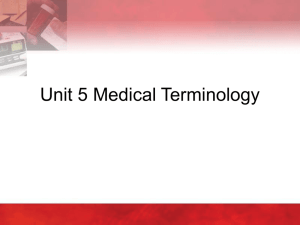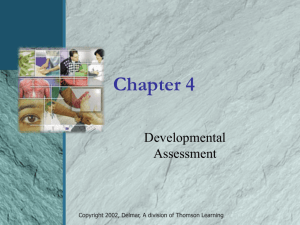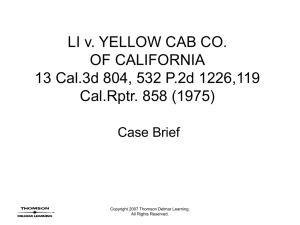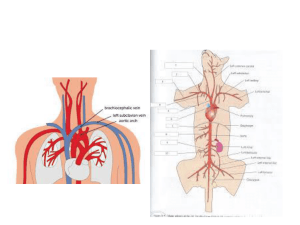Chapter 2
advertisement
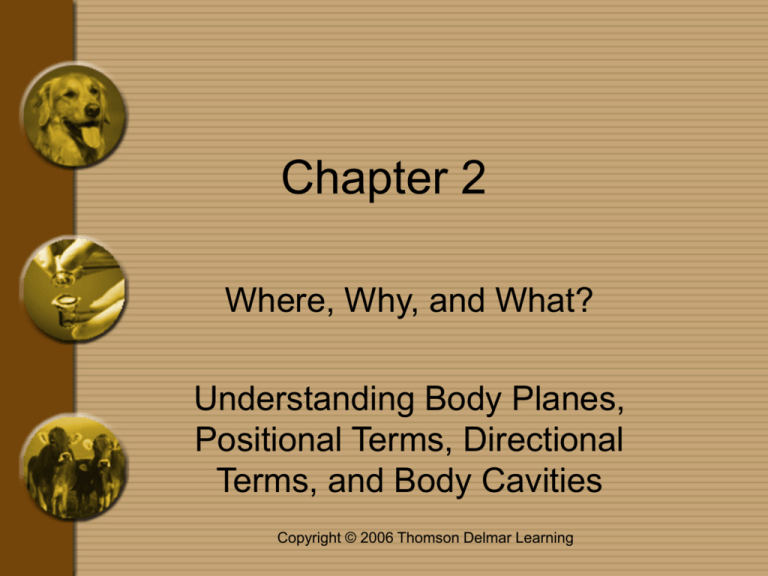
Chapter 2 Where, Why, and What? Understanding Body Planes, Positional Terms, Directional Terms, and Body Cavities Copyright © 2006 Thomson Delmar Learning In Position • Positional terms are important for accurately and concisely describing body locations and relationships of one body structure to another • Terms like forward and backward, up and down, in and out, and side to side may not be clear enough descriptions for universal understanding Copyright © 2006 Thomson Delmar Learning Body Directions • Relative location of the whole body or an organ is described through the use of pairs of contrasting body direction terms • Medial versus lateral: – Medial is toward midline – Lateral is away from midline Copyright © 2006 Thomson Delmar Learning Body Directions • ventral versus dorsal (C and D) • cranial versus caudal (A and B) • rostral versus caudal (E and B) – cephalic also means pertaining to the head • proximal versus distal (F and G) • palmar versus plantar (H and I) • anterior versus posterior • superior versus inferior • superficial versus deep Copyright © 2006 Thomson Delmar Learning Body Planes • Planes are imaginary lines used descriptively to divide the body into sections • Planes of the body include – midsagittal plane: plane that divides the body into equal right and left halves • also called the median plane and midline – sagittal plane: plane that divides the body into right and left parts – dorsal plane: plane that divides the body into dorsal (back) and ventral (belly) parts • also known as the frontal plane or coronal plane – transverse plane: plane that divides the body into cranial and caudal parts • also known as the horizontal plane or cross-sectional plane Copyright © 2006 Thomson Delmar Learning Planes of the Body Copyright © 2006 Thomson Delmar Learning Study Terms • The suffix -logy means the study of • Terms with -logy are used to describe specific branches of study • Anatomy – study of body structure • Physiology – study of body function • Pathology – study of the nature, causes, and development of abnormal conditions • Etiology – study of disease Copyright © 2006 Thomson Delmar Learning Mouth Terms • Dental arcade – arrangement of teeth in mouth • Lingual surface – aspect of the tooth facing tongue • Buccal surface – aspect of the tooth facing cheek • Occlusal surface – aspect of the teeth that meet when you chew • Labial surface – tooth surface facing the lips • Contact surface – aspects of the tooth that touch other teeth • mesial contact • distal contact Copyright © 2006 Thomson Delmar Learning The Hole Truth • A body cavity is a hole or hollow space within the body that contains and protects internal organs • There are many body cavities within an animal • Spinal cavity – contains the spinal cord within the spinal column Thoracic cavity/chest cavity – contains the heart and lungs within the ribs and between the neck and diaphragm • Pelvic cavity – contains the reproductive and some excretory organs formed by the pelvic bones Cranial cavity – contains the brain in the skull • • • Abdominal cavity – contains the major organs of digestion between the diaphragm and pelvic cavity • also known as the “peritoneal cavity” Copyright © 2006 Thomson Delmar Learning Lying Around • The medical term for lying down is recumbent • Recumbent positions are then described by the body part that is being laid upon – – – – dorsal recumbency: lying on the back ventral recumbency: lying on the belly left lateral recumbency: lying on the left side right lateral recumbency: lying on the right side Copyright © 2006 Thomson Delmar Learning Recumbency Positions Copyright © 2006 Thomson Delmar Learning Movement Terms • Adduction – to move toward midline – think “add” • Abduction – to move away from midline – think child abduction means to take the child away Copyright © 2006 Thomson Delmar Learning Movement Terms • Flexion – bending a joint or reducing the angle between two bones • Extension – straightening a joint or increasing the angle between two bones Copyright © 2006 Thomson Delmar Learning Cyte Terms • Cells are the basic structural units of the body – Cyt/o means cell – Cytology is the study of cells • Protoplasm consists of the cell membrane, cytoplasm and nucleus – -plasm means formative material of cells – Prot/o means first Copyright © 2006 Thomson Delmar Learning It’s in the Genes • Genetic means something that pertains to genes or heredity • Genetic disorder is any disease or condition caused by defective genes – also known as hereditary disorders • Congenital denotes something that is present at birth – a genetic defect may be congenital • Anomaly is a deviation from what is regarded as normal Copyright © 2006 Thomson Delmar Learning Grouping Things Together • A tissue is a group of specialized cells that join together to perform a certain function • Histology is the study of tissues – Hist/o means tissue; -logy means the study of • There are four main tissue types – – – – epithelial connective muscle nervous Copyright © 2006 Thomson Delmar Learning Pathology of Tissue • Tissue can form normally or abnormally • -plasia describes formation, development, and growth of tissue and cell numbers • -trophy describes formation, development, and increased size of tissue and cells • Prefixes used to describe tissue growth: – a- means without – hypo- means less than normal – hyper- means more than normal – dys- means bad – ana- means without – neo- means new Copyright © 2006 Thomson Delmar Learning Tumor Terms • Neoplasia = any abnormal growth of tissue in which multiplication of cells is uncontrolled, more rapid than normal, and progressive – tumor: a distinct mass of tissue formed from a neoplasm (-oma means tumor or neoplasm) • benign: not recurring • malignant: tending to spread and become life-threatening Copyright © 2006 Thomson Delmar Learning Glands • Glands are groups of specialized cells that secrete material used elsewhere in the body – aden/o means gland • Exocrine glands are glands that secrete material into ducts – Exo- means out, crine means to secrete • Endocrine glands are glands that secrete chemicals into the bloodstream for transportation to organs and other structures throughout the body – Endo- means within, crine means to secrete Copyright © 2006 Thomson Delmar Learning Organs • An organ is a part of the body that performs a special function or functions • Each organ has its own combining form or forms – See text Table 2-2 • These combining forms usually have Latin or Greek origins • If an organ has more than one combining form, – the Latin form is used to describe or modify something • Ren/o means kidney and is used in the terms renal disease and renal tubule – the Greek form is used to describe a pathological finding • Nephr/o means kidney and is used in the term nephritis and nephropathy Copyright © 2006 Thomson Delmar Learning Number Prefixes • Medical terms can be modified by the use of prefixes to assign number value, numerical order, or parts of a whole • Refer to text Table 2-3 to see the Latin and Greek number prefixes for the numbers 1 through 10 Copyright © 2006 Thomson Delmar Learning
